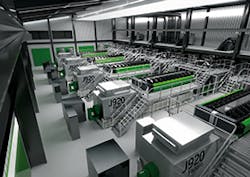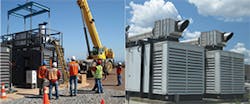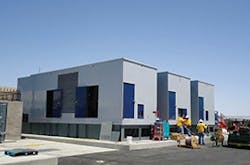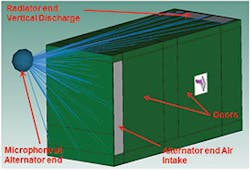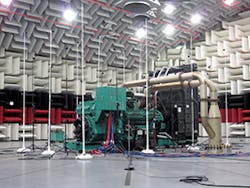Emissions
Onsite energy continues to prove itself as an economical and sustainable solution for businesses and institutions. But as it grows in popularity, the marketplace and government agencies are adding regulations for noise, emissions, and fuel handling. In the past such requirements would have slowed progress, but today there’s good news from a variety of manufacturers that have developed innovative solutions to these market challenges. Let’s take a look at some examples of these technologies, and we’ll include news about a cutting edge project that demonstrates how hydrogen manufactured from renewable energy can answer the demand for a clean sustainable fuel product.
Speaking of renewable energy resources, wind and solar continue to dominate the market for new utility scale energy development. As these multi-megawatt-sized projects connect to the grid, problems from intermittent performance challenge grid operators who must balance voltage and power requirements. In June 2014, GE Distributed Power introduced a solution designed to help with grid balancing in North America; the fast-reacting Jenbacher J920 FleXtra Generator Set. While initially targeting the market for supporting utility operations, the FleXtra line could find use in applications such as onsite power for universities and other large power users.
Key features for the 10-MW class, 60-Hz gas engines include electrical efficiency of 49% and a five-minute startup time. “FleXtra means flexibility and extra high efficiency,” says Patrick Frigge, product line leader for 10-MW class engines at GE’s new Distributed Power Business. “So, the engine we have here has 49% electrical efficiency, and it’s the highest efficiency in a 10-megawatt range. It’s highly flexible because it can run on ramp up or drop load very fast.”
Pilot program power plant
According to Scott Nolan, global solutions leader for GE’s Distributed Power Business for Gas Turbine and Diesel Engines, as renewables join the grid, operators need to react quickly to fluctuations. “We designed this product to be able to pick up or drop load very fast—at three megawatts per minute. And, because you can preheat an engine’s oil even though it’s standing still, it’s warm, so it can start generating 8.5 megawatts within five minutes.”
The electrical efficiency of 49% for 60 Hz can offer significant savings in fuel over the life cycle of a power plant. For example, GE predicts that in a 15-year period, a US facility could realize fuel savings of as much as $15 million for a 100-MW J920 FleXtra power plant with very high simple-cycle efficiency.
“There are three building blocks that allow us to increase efficiency,” explains Frigge. “We use advanced combustion systems, two-stage turbocharging technology, and advanced electronic controls. Then, there are also standard measures such as reducing the friction in the engine, and that helps.”
In GE’s comparisons with other gas engines in the same output range, the J920 is capable of preventing the equivalent of about 1,500 tons of carbon dioxide emissions annually and saving more than 6.4 million kWh of natural gas per year.
The lower emissions and fuel savings should appeal to businesses and institutions with high megawatt loads, notes Scott Nolan. “District heating and universities are perfect applications. Because of the engine’s low impact you can locate them right in the center of campus and replace boiler systems that may have burned coal or natural gas. We get about the same amount of heat energy as the electricity, so with the combination of electrical and thermal energy it operates at an efficiency of over 90%. So, the energy from the fuel is going out in the form of electricity or heat that we can capture in the form of hot water.”
Emissions Onsite energy continues to prove itself as an economical and sustainable solution for businesses and institutions. But as it grows in popularity, the marketplace and government agencies are adding regulations for noise, emissions, and fuel handling. In the past such requirements would have slowed progress, but today there’s good news from a variety of manufacturers that have developed innovative solutions to these market challenges. Let’s take a look at some examples of these technologies, and we’ll include news about a cutting edge project that demonstrates how hydrogen manufactured from renewable energy can answer the demand for a clean sustainable fuel product. Speaking of renewable energy resources, wind and solar continue to dominate the market for new utility scale energy development. As these multi-megawatt-sized projects connect to the grid, problems from intermittent performance challenge grid operators who must balance voltage and power requirements. In June 2014, GE Distributed Power introduced a solution designed to help with grid balancing in North America; the fast-reacting Jenbacher J920 FleXtra Generator Set. While initially targeting the market for supporting utility operations, the FleXtra line could find use in applications such as onsite power for universities and other large power users. Key features for the 10-MW class, 60-Hz gas engines include electrical efficiency of 49% and a five-minute startup time. “FleXtra means flexibility and extra high efficiency,” says Patrick Frigge, product line leader for 10-MW class engines at GE’s new Distributed Power Business. “So, the engine we have here has 49% electrical efficiency, and it’s the highest efficiency in a 10-megawatt range. It’s highly flexible because it can run on ramp up or drop load very fast.” [caption id="attachment_93" align="alignleft" width="270"]While the FleXtra line is designed for natural gas, for large gensets in the 10-MW range there is a demand for biogas-fueled CHP cogeneration plants. For example, 2G CENERGY will supply a 9.4-MW modular energy conversion system to the Solid Waste Authority of Central Ohio (SWACO), for a waste-to-energy and materials recovery facility that combines landfill gas with anaerobic digester gas from a waste stream recovery plant.
Ultimately, the plant will process up to 2,000 tons per day (about 30% of the current waste stream), with plans to process the entire waste stream in the future—thus achieving nearly 100% recycling of all the waste received.
The modular 2G biogas cogeneration system for the first phase is rated 5,550 kWh (5.55 MWh) consisting of three integrated 2G Avus Series CHP units. The cogeneration system comes with ultra-low NOx and CO emissions control technology.
“Traditional gas treatment systems for a plant of this size could run into the millions of dollars,” says Michael Turwitt, president, 2G Cenergy. “But ours is sized to be very efficient, and it’s well below a million dollars in cost. It’s fully assembled and tested at the factory, and then we disassemble it and send it to the job site. We provide a package that comes delivered in modules that fit together, so it’s plug-and-play.”
Modular systems have enjoyed popularity in Europe for many years, and Turwitt sees the method growing rapidly in the US because it offers a significant advantages. “Everything comes pretested and pre-installed, and for project owners that’s a big benefit. [That way] they don’t have too many vendors trying to put something together and being uncertain as to how the system will operate once it’s assembled.”
The Avus Series meets Ohio’s emissions standards and qualifies in most of the US, but there are some areas that require extra exhaust treatment. “California, Massachusetts, New Jersey, and Hawaiian Islands have regulations that are particularly strict, and we would need some treatment for our emissions,” says Turwitt. “But that’s integrated into our modules for customers located in those states.”
The units also meet the growing requirements for sound attenuation. “Our standard packages are sound attenuated for quiet sound levels typically at 65 decibels as our standard range, but we have a super silent option that drops sound below 50 decibels.”
Emissions and noise solutions for power generation equipment need to keep up with genset design.
Noise
The power generation industry is paying close attention to the issue of noise control, according to Dawn Auby, director of marketing at Universal Acoustic & Emission Technologies, a manufacturer of solutions for noise control, air filtration, and emissions. “The demands for higher performing sound attenuating products is growing,” says Auby. “And the solutions often involve enclosures.”
To better serve its customers, Universal recently acquired Ojibway Enclosure Systems, a manufacturer of enclosures and packager of generator sets for power generation systems. Ojibway also does laser cutting, welding, and forming of a variety of metal products, and it assists in the installation of generator sets in the field. Demand for onsite power systems has resulted in Ojibway and Universal having shared many common customers, including engine distributors who source silencers, complete power generation packages or emissions treatment products for data centers, hospitals, and other large-scale facilities that require standby power generators.
These customers are concerned about the demand from local governments that take noise control seriously, according to Debbie Schilling, senior business development manager at Ojibway. “Certainly municipalities and communities are cracking down on the sound codes that have always existed,” says Schilling. “And now they are enforcing them stringently, so we’re seeing a significant increase in requests for acoustical requirements. Traditionally, customers were happy with a factory enclosures that could achieve a 25-dBA [A-weighted decibels] reduction. But companies are expanding their footprint into a variety of locations where generators and enclosures are located. So they can end up right next to an apartment building or across the street from a school, and designers are more cognizant of this.”
Meeting the requirements of designers often includes the use of silencers, which are typically integrated into the enclosure. “It’s especially important with engine enclosures,” notes Schilling. “When you’re talking about compressor and blower enclosures for the industrial market, they will certainly include silencers. And then of course, with the turbine market they have exhaust silencers and inlet silencers. But I think that knowing the local codes is one of the biggest things when you’re looking for an enclosure. It’s something that’s often overlooked and there are many local codes that could be enforced at any time. Also, you must know the environment you’re in such as high heat or altitude, and any sort of extreme weather conditions that could impact the enclosure.”
Factors such as the environment and generator designs are adding to the complexity of noise control. But according to Don Lambert, business development manager, Miratech, these challenges are often opportunities to develop innovative solutions. Miratech supplies emission solutions for stationary natural gas and diesel reciprocating engines, and Lambert notes that noise is becoming just as important as pollution.
“It’s been surprising over the last five years or so how much noise emissions are becoming a bigger concern,” says Lambert. “Now it’s regulated in many parts of the country, and in some areas it was always regulated, but now it’s being enforced.”
Overall, there are multiple challenges for customers with noise, emissions, and heat issues. “The old knee-jerk mindset would be to just put a muffler on a noise problem, but we’ve found that when you reach a point where you reduce the exhaust noise such that it’s no longer the loudest source of noise on the package, you still have noise to remedy and a specific noise target for the site, whether it’s from the exhaust or another source of noise in the package, such as mechanical noise from the engine. Another source could be the radiator or cooling system, and there’s intake noise from high-frequency turbochargers and the air filter assemblies. So it’s important to know what to attack and how to attack it so that you solve the problem exactly, rather than using a trial and error attempt to solve it.”
The subject of knowing what to attack is an area of intense study and analysis at the Acoustical Testing Center (ATC) at the Fridley plant of Cummins Power Generation. Acknowledged as the largest engine-testing facility of its kind in the world, the ATC features a 13,000 square foot state-of-the-art hemispherical anechoic (no echo) chamber, allowing for precise measurement of the noise output from fully assembled generator sets of all types and sizes.
According to Martin Myers, acoustic testing begins with understanding the sources of noise such as the engine, the alternator, and the cooling fans. However, the Cummins team also does in-depth work to understand the characteristics of the sources of noise.
“The best way to approach noise is to reduce or eliminate the source,” says Myers, “but of course you’re not going to make an engine that doesn’t have noise. So you accept that the engine and cooling system produce a level of noise and if you can understand that source you can begin to design an enclosure in such a way that it will mitigate some of those output noises.” Some examples of common sources of noise include turbochargers (typically running at 100 to 120,000 RPMs), cooling fan blades, the noise from air movement, and alternators.
Enclosures
To understand noise at its source, researchers look at basics such as the frequency band of noise (low or high pitch), because it can determine the materials and design of an enclosure. “Enclosures use some form of sheet metal such as aluminum or steel,” explains Myers. “We understand that as we change the thickness of the steel or switch from steel to aluminum, the acoustic characteristics of these materials are different and will change the noise. Acoustic insulation is used, and we’ve done a lot of work on how the combinations of those materials work. So, if we have specific noise coming from a genset in a certain frequency range, we can go and essentially model and target how to eliminate that specific frequency.”
Myers notes that in the area of establishing national regulations for noise, the US lags behind Europe (Conformité Européenne Noise Directive based acoustic measurements), and India (CPCB-II–The Central Pollution Control Board of India). Worldwide, the ISO (International Organization for Standardization) has established testing standards. In the US, both the SAE (Society of Automotive Engineers), and ANSI (American National Standards Institute) have set testing standards. For the future, Myers expects to see continued growth in the application of standards in the US and more sensitivity to noise in the workplace.
“Regulations are changing, and we need to be aware of it, but it’s not only from a legislative perspective. There is also a customer perception and a market force out there that pushes for improvements.”
2,250-kW Level 1 enclosures for MTU gensets
A recent project that involved backup power for a water utility provides a good example. The City of Broken Arrow, a suburb of Tulsa, OK, recently upgraded its water treatment plant, and three Cummins 2-MW generators were specified for emergency backup power. Even though the location wasn’t close to a residential area, the environmental and acoustic specifications required special enclosures and fuel tanks for the generator sets. These were complex enclosures. Each measured 40 feet long by 10 feet wide, and nearly 14 feet high, to allow ample airflow and provide a 25-dBA sound reduction. Hennig Enclosure Systems of Machesney Park, IL, won the contract to manufacture the enclosures and fuel tanks, in addition to mounting the gensets and handling all the electrical connections, adds Al Grabowski at Hennig.
Stricter and lower dBA requirements are driving enclosure designs, he says. “With the push by engine manufacturers to get more horsepower out of their engines, the bigger cooling systems and the emissions requirements mean they run the engines hotter,” says Grabowski. “They need bigger radiators that have bigger fans and more noise. So the challenge is to reduce that sound level. Now there are new design solutions that use insulation and baffling, but once you put baffling in, it restricts airflow. And it’s something of a Catch-22, you have to allow for enough airflow.”
Considerations for harsh weather and corrosion are also necessities. Hennig provided a topcoat finish of TGIC polyester powder coat paint for weather resistance and UV protection, plus stainless steel hardware.
“The weather is hard on these enclosures, and a service technician may only be out there once or twice a year for servicing and maintenance,” adds Grabowski. “These enclosures are rated for 100-mile-per-hour winds, and they withstand extreme weather like hailstorms.”
Extreme weather can be tough on the exhaust/silencer hardware on a genset, but the fuel source also has an impact on the system’s life, according to Dale Gremaux, sales marketing manager at Harco Manufacturing. Harco manufactures heavy-duty commercial exhaust silencers and supporting products, and Gremaux notes that the use of natural gas is affecting design decisions. “Stainless steel is required, due to the fact that natural gas is being used more as a fuel for backup generators and it burns hotter,” says Gremaux.
Another trend is the use of larger gensets. “In the past the typical power range ran from three kilowatts to five megawatts,” says Gremaux. “But now we’re called upon to design sound attenuation for larger machines. They are louder, and, from our experience, we know that certain brands run louder than others, so what will work for one manufacturer won’t work for another.”
With so many variables, custom work is common and Harco uses 3D virtual prototyping to develop silencers. “With computers we can run multiple simulations and virtual tests without having to assemble something,” says Gremaux. The designs can be complex, so the company recently added an integrated flying bridge waterjet cutting system that’s capable of cutting complex shapes in almost any material.
Engine genset noise testing at the Acoustical Testings Center, Fridley plant, Cummins Power Generation
Fuel
While local and state regulations for sound continue to get tougher, a similar story is playing out with emissions. California has often led the US in setting low emissions requirements, and The California Air Resources Board (CARB) recently updated climate change legislation designed to reduce greenhouse gas emissions. Regulations are particularly stringent for diesel emissions, but owners of diesel equipment have a solution with Miratech’s new Diesel Particulate Filter. The filter is CARB Level 3 Plus Conditionally Verified and offers stationary diesel engine owners/operators a single-housing assembly optimized for low-temperature regeneration and integrated silencing. The low-temperature system can regenerate at temperatures as low as 500°F/260°F. The modular filters are stackable to tailor PM reduction capacity to an engine’s specific needs. The filter construction also affords maximum soot trapping and “storage” capacity while staying within the back pressure limits of the engine.
Diesel fuel storage is also a concern for backup generators, and tanks must meet a variety of federal codes for combustible fuel storage, as well as various local and state codes. Universal Acoustic & Emission Technologies has added fuel tank manufacturing to its product line, as an integral component of generator set packages provided by Ojibway Enclosures by Universal. Customers can choose from multiple lifting options and I-beam structural support or a flat-top design with internal support for the generator. The UL 142-listed tanks are certified for both the US and Canada.
Compared to natural gas, diesel fuel requires heavy-duty emissions hardware, and diesel can degrade with long-term storage. Although natural gas burns cleaner, there’s another gas that’s considered to be free of emissions and that is hydrogen. As a fuel for cogeneration or backup, hydrogen is much less prevalent than natural gas and diesel-fueled applications. But what if there was a renewable energy resource to create safe hydrogen that can be stored for use in onsite power applications? And, how about a new engine that generates heat and electricity from hydrogen? No need to wait; it’s already happening.
We’re talking about the dedicated hydrogen-fueled reciprocating engine-based CHP cogeneration system from 2G Cenergy. The first units are operating at the Berlin Brandenburg Willy Brandt Airport’s energy station, where two hydrogen-fueled engines power 2G’s Agenitor CHP systems, with an output of 400 kW per unit (units are capable of 500-kW output). The CHP plant is integrated with a larger hydrogen vehicle fueling project operated by a multinational consortium that includes Total (oil and gas distribution, commercial filling stations), Enertrag (renewable energy and wind turbine project operator), and the Linde Group (industrial gas supplier and hydrogen plant operator).
With the installation of the CHP system, the existing hydrogen vehicle fueling station became a self-contained hydrogen complex. The entire project incorporates a wind farm and solar panels that are capable of powering a 100% renewable system when combined with an electrolyzer that produces about 200 kg of hydrogen per day (equivalent to about 50 full tanks of fuel cell cars).
Germany has a strong track record in supporting renewable energy, so finding a viable storage technology is an obvious need. From a global viewpoint, energy storage is growing. According to Navigant Research, in the first six months of 2013, 38 new advanced energy storage projects were planned or deployed. That amounts to a worldwide total of 633 energy storage projects operating or under development. Most of the significant hydrogen storage projects that are making progress have some form of government funding.
In the US, only a few wind-to-hydrogen projects have been developed. The National Renewable Energy Laboratory (NREL), a division of the US Department of Energy (DOE) partnered with utility supplier Xcel Energy on a demonstration project at the National Wind Technology Center in Boulder, CO. In December 2008, the NREL operated a Mercedes Benz F-Cell fuel cell vehicle with hydrogen, wind and PV, but the pilot lasted only a year. More recently, a $4.6-million DOE grant funded a wind turbine to power a water-to-hydrogen process, with the ultimate goal of fueling a hydrogen vehicle and a bus in the Town of Hempstead, NY.
According to 2G Cenergy’s Turwitt, the advantage of storing hydrogen as a fuel for reciprocating engines is a matter of both sustainability and economics. “The idea to utilize fuel cells for power generation sounds very attractive for clean and efficient energy production,” says Turwitt. “However, there are still issues associated with the technology, such as very high manufacturing costs.”
Studies by the National Fuel Cell Research Center, University of California, Irvine, CA, say that fuel cells could become competitive with traditional engine technologies if they reach an installed cost of $1,500, or less, per kilowatt. But currently, the cost is in the range of US $4,000+ per kilowatt. Meanwhile, the prices are US $800 to $1,500 for reciprocating engine CHP system technologies, and Turwitt expects to see a broad range of applications for 2G Cenergy’s products.
Turwitt’s predictions could be applied to many different technologies that support onsite power generation. Much of the demand arises from new regulations. However, the marketplace is driven by demands from customers for sustainability and higher performance where noise, emissions, and fuel handling are concerned. As seen from our cross section of manufacturers, these demands will drive innovating products that benefit the industry and its customers.

